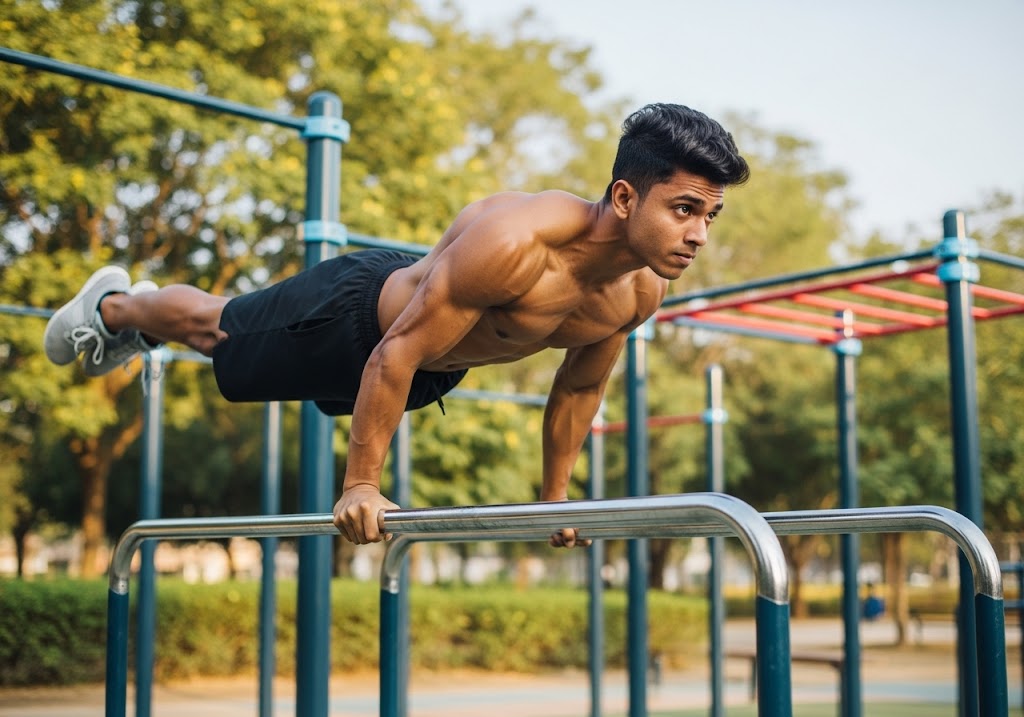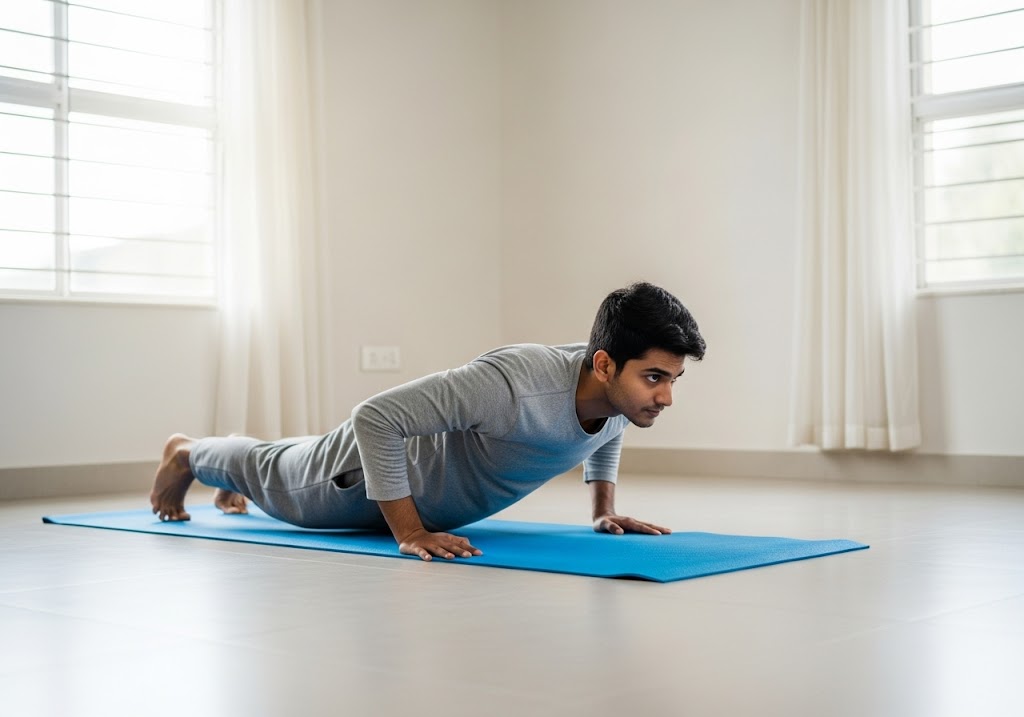8 Essential Steps for How to Do Plank Exercise are starting position for proper hand and forearm setup, body alignment for a straight line from head to heels, core engagement to activate abdominal muscles, breathing pattern for steady oxygen flow, shoulder position for upper body stability, hip alignment for lower body control, leg engagement to maintain full-body tension, and duration control to build endurance progressively.
Learning how to do plank exercise correctly transforms your core strength and overall fitness in ways few exercises can match. This comprehensive guide teaches you how to do plank exercise with perfect form, avoiding common mistakes that reduce effectiveness. Understanding how to do plank exercise properly ensures you maximize benefits while minimizing injury risk.
Table of Contents
8 Essential Steps – How to Do Plank Exercise?
Mastering how to do plank exercise requires understanding each component that contributes to perfect form and maximum effectiveness. This systematic breakdown reveals why proper technique is crucial for experiencing the full benefits of this powerful core exercise.
| Step | Component | Focus Area | Common Error |
| 1. Starting Position | Foundation setup | Hands and forearms | Improper alignment |
| 2. Body Alignment | Straight line | Head to heels | Sagging hips |
| 3. Core Engagement | Muscle activation | Abdominal muscles | Weak core |
| 4. Breathing Pattern | Oxygen flow | Steady rhythm | Holding breath |
| 5. Shoulder Position | Upper body stability | Shoulder blades | Rounded shoulders |
| 6. Hip Alignment | Lower body control | Neutral position | Raised hips |
| 7. Leg Engagement | Full body tension | Quadriceps and glutes | Relaxed legs |
| 8. Duration Control | Time management | Progressive holds | Excessive duration |
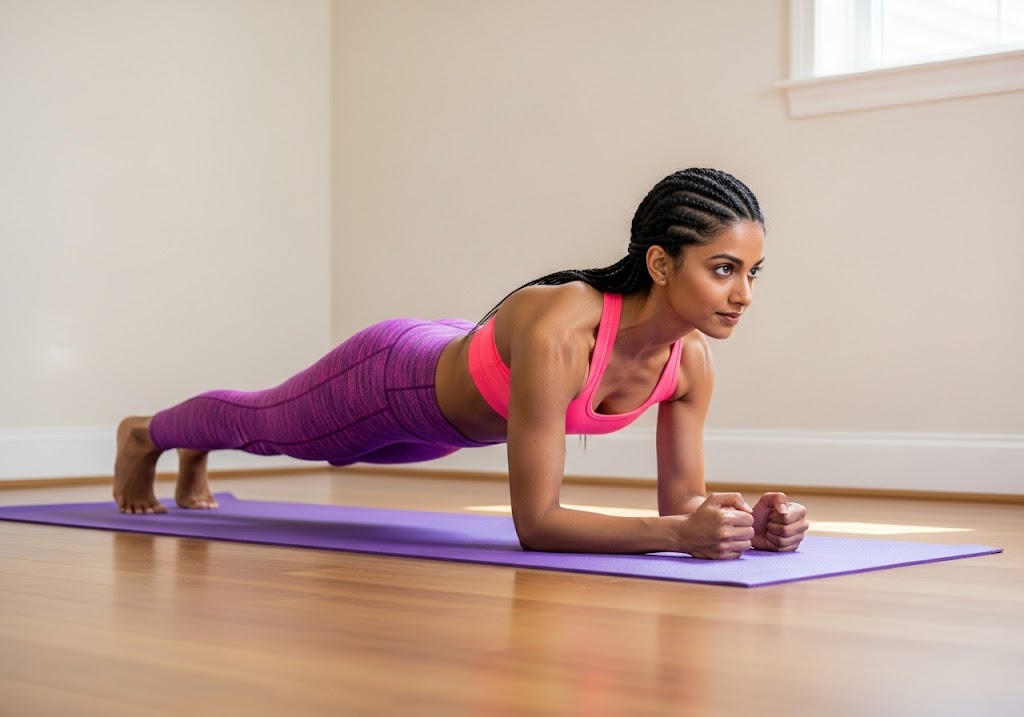
Detailed Step-by-Step Instructions
1. Starting Position
Establishing the proper starting position creates the foundation for effective plank execution and prevents common alignment issues that compromise exercise effectiveness. The relationship between your hands, forearms, and body positioning determines whether you’ll maintain proper form throughout the hold. Taking time to set up correctly prevents compensatory movements that can lead to discomfort or reduced muscle activation.
Tips for Starting Position
- Place forearms on ground with elbows directly under shoulders, not forward or behind shoulder line
- Keep forearms parallel to each other or form slight triangle with hands touching for stability
- Start on knees before extending to full plank position to check alignment before adding difficulty
- Position yourself over a mirror or ask someone to check your setup from the side view
- Make small adjustments to elbow position until you feel balanced and stable in the starting position
2. Body Alignment
Perfect body alignment from head to heels ensures maximum core activation while protecting the lower back from excessive stress. This straight-line position distributes your body weight evenly across all supporting muscles rather than placing undue stress on any single area. Maintaining alignment becomes more challenging as fatigue sets in, making it essential to understand what proper alignment feels like from the beginning.
Tips for Body Alignment
- Imagine a straight line drawn from the top of your head through your spine to your heels
- Keep your head in neutral position by looking down at the floor rather than forward or up
- Avoid letting your hips sag down toward the floor or pike up toward the ceiling
- Think about creating a tabletop with your back that could hold a glass of water without spilling
- Check your alignment by practicing against a wall or having someone place a broomstick along your back
3. Core Engagement
Proper core engagement transforms the plank from a passive hold into an active strengthening exercise that targets deep stabilizing muscles. Core activation should feel like you’re gently drawing your belly button toward your spine while maintaining normal breathing patterns. This internal tension creates the stability necessary to maintain proper alignment and maximizes the exercise’s effectiveness for building core strength.
Tips for Core Engagement
- Gently draw your belly button toward your spine without sucking in your stomach dramatically
- Think about tightening your core as if someone were about to give you a gentle poke in the stomach
- Maintain core tension throughout the entire hold, not just at the beginning of the exercise
- Practice core engagement while lying on your back before attempting the plank position
- Focus on activating deep core muscles rather than just the surface abdominal muscles you can see
4. Breathing Pattern
Maintaining steady, controlled breathing during planks prevents unnecessary tension while ensuring adequate oxygen delivery to working muscles. Many people instinctively hold their breath during challenging exercises, but this reduces performance and can cause dizziness or premature fatigue. Learning to breathe normally while maintaining core tension is a skill that improves with practice and enhances overall exercise effectiveness.
Tips for Breathing Pattern
- Breathe in and out through your nose at a steady, comfortable pace throughout the hold
- Count your breaths to help maintain rhythm and track your progress over time
- If you catch yourself holding your breath, consciously return to normal breathing without losing core tension
- Practice breathing while engaging your core in easier positions before progressing to full planks
- Use breathing as a way to stay calm and focused rather than fighting against the difficulty of the exercise
5. Shoulder Position
Proper shoulder positioning provides upper body stability while preventing unnecessary strain on the neck and upper back muscles. Your shoulders should remain directly over your elbows with shoulder blades pulled slightly back and down, creating a stable platform for the rest of your body. Poor shoulder positioning can lead to discomfort and reduced exercise effectiveness while potentially causing neck or shoulder problems.
Tips for Shoulder Position
- Keep your shoulders directly over your elbows rather than allowing them to drift forward or backward
- Gently pull your shoulder blades back and down to create stability in your upper back
- Avoid hunching your shoulders up toward your ears, which creates unnecessary tension
- Think about creating width across your upper back rather than allowing your shoulders to collapse inward
- If your shoulders fatigue before your core, focus on building shoulder strength with easier plank variations first
6. Hip Alignment
Hip alignment determines whether your plank effectively targets the core muscles or places excessive stress on the lower back. Your hips should remain in neutral position, neither sagging toward the floor nor piking up toward the ceiling. Proper hip alignment ensures that your core muscles work to stabilize your spine rather than compensating for poor positioning that reduces exercise effectiveness.
Tips for Hip Alignment
- Keep your hips level with your shoulders and heels, avoiding sagging or piking positions
- Engage your glute muscles gently to help maintain neutral hip position throughout the hold
- If your hips start to sag, either take a break or modify to an easier variation like knee planks
- Think about keeping your belt line parallel to the floor if you were wearing a belt
- Practice hip alignment in easier positions before progressing to more challenging plank variations
7. Leg Engagement
Active leg engagement creates full-body tension that enhances core activation and helps maintain proper alignment throughout the plank hold. Your legs should be straight and active rather than simply hanging from your hips, with gentle tension in your quadriceps and glutes. This full-body approach to planking creates better results and helps prevent the hips from sagging due to weak or inactive leg muscles.
Tips for Leg Engagement
- Keep your legs straight and active by gently contracting your quadriceps muscles throughout the hold
- Engage your glute muscles to help support your hips and create stability through your lower body
- Think about pushing your heels away from your body while maintaining contact with the ground
- Avoid locking your knees rigidly, instead maintaining gentle but consistent muscle tension
- If leg fatigue occurs before core fatigue, work on building leg strength through other exercises as well
8. Duration Control
Smart duration control focuses on maintaining perfect form rather than simply holding the position for as long as possible regardless of technique quality. Starting with shorter holds and gradually increasing duration allows your body to adapt while maintaining proper alignment and muscle activation. Quality always takes precedence over quantity when it comes to plank duration and overall exercise effectiveness.
Tips for Duration Control
- Take breaks between sets rather than attempting single extremely long holds that compromise form quality
- Start with 10-20 second holds and gradually increase duration as your strength and form improve
- Stop the exercise when you can no longer maintain proper alignment rather than pushing to failure
- Focus on perfect form for shorter durations rather than compromised form for longer holds
- Track your progress by noting improvements in duration while maintaining perfect technique
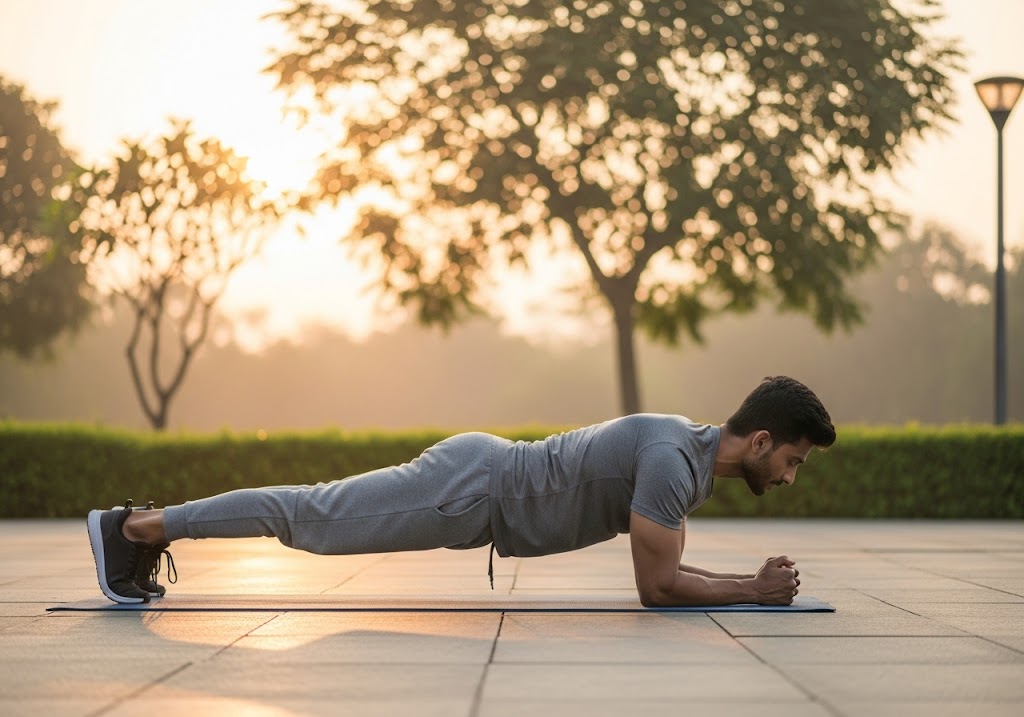
What is Plank Exercise?
Learning how to do plank exercise begins with understanding this isometric core exercise where you maintain a straight body position supported by forearms and toes. This static hold targets multiple muscle groups simultaneously, making it highly effective for building core strength, stability, and endurance throughout your entire body.
Types of Plank Exercises to Try
Exploring different plank variations helps you progress beyond basic techniques while learning how to do plank exercise in new ways. Each variation targets specific muscle groups while maintaining the core benefits of traditional planks.
| Variation | Difficulty | Primary Focus | Equipment Needed |
| Standard Plank | Beginner | Core stability | None |
| Side Plank | Intermediate | Obliques | None |
| Plank Up-Down | Intermediate | Dynamic core | None |
| Plank with Leg Lifts | Intermediate | Glutes and core | None |
| Plank Jacks | Advanced | Cardio and core | None |
| Single-Arm Plank | Advanced | Unilateral strength | None |
| Plank with Knee Tucks | Advanced | Hip flexors | None |
| Weighted Plank | Advanced | Increased resistance | Weight plate |
1. Standard Plank
The standard plank serves as the foundation for all plank variations, teaching proper alignment and core engagement essential for more advanced movements. This isometric exercise builds deep core strength while improving posture and spinal stability through sustained muscle contraction. Mastering the standard plank with perfect form for 30-60 seconds is prerequisite before progressing to more challenging variations that require greater strength and coordination.
How to Do Standard Plank?
- Start in forearm plank position with elbows under shoulders, maintaining straight line from head to heels
- Engage core by gently drawing belly button toward spine while breathing normally throughout hold
- Hold position for 15-60 seconds depending on fitness level, focusing on perfect form over duration
2. Side Plank
Side planks specifically target the oblique muscles and lateral core stabilizers often neglected in traditional front planks. This unilateral exercise challenges balance and coordination while building strength through the frontal plane of movement. Side planks help correct muscle imbalances while improving spine stability in multiple directions, making them essential for comprehensive core development and functional movement patterns.
How to Do Side Plank?
- Lie on side with forearm on ground, elbow under shoulder, and stack feet on top of each other
- Lift hips off ground creating straight line from head to feet, keeping body in single plane
- Hold for 15-45 seconds per side, avoiding rotation or allowing hips to sag toward ground
3. Plank Up-Down
Plank up-downs add dynamic movement to traditional plank holds, challenging core stability while building upper body strength and endurance. This exercise requires coordination between core engagement and arm movement while maintaining proper spinal alignment throughout the transition phases. The dynamic nature increases cardiovascular demand while building functional strength through movement patterns that translate to daily activities.
How to Do Plank Up-Down?
- Start in forearm plank, press up to high plank one arm at a time, then lower back down
- Keep hips level and minimize rotation during transitions between forearm and hand positions
- Alternate which arm leads the movement and perform 5-10 total transitions with control
4. Plank with Leg Lifts
Plank with leg lifts combines core stability with glute activation, creating increased challenge for the posterior chain and hip stabilizers. This exercise requires maintaining perfect plank position while moving one limb, demanding exceptional core control and coordination. The unilateral leg movement challenges balance while specifically targeting glute strength and hip stability essential for athletic performance and injury prevention.
How to Do Plank with Leg Lifts?
- Hold standard plank position, lift one leg 6-12 inches off ground while maintaining core stability
- Keep lifted leg straight and avoid rotating hips or allowing opposite hip to drop
- Hold leg lift for 2-5 seconds, lower with control, then alternate legs for 5-10 repetitions per side
5. Plank Jacks
Plank jacks combine cardiovascular training with core strengthening through dynamic leg movement while maintaining plank position. This exercise elevates heart rate while challenging core stability and coordination through rapid leg movements. The combination of cardio and strength training makes plank jacks excellent for high-intensity workouts while building exceptional core endurance and full-body conditioning.
How to Do Plank Jacks?
- Start in high plank position, jump feet apart and back together while maintaining stable upper body
- Keep hands planted and core engaged, avoiding bouncing hips or losing spinal alignment
- Perform 10-20 repetitions at controlled pace, focusing on form over speed throughout movement
6. Single-Arm Plank
Single-arm planks create extreme core challenge by removing one support point, demanding exceptional stability and strength from remaining muscles. This advanced exercise targets anti-rotation strength while building unilateral core power essential for athletic performance and functional movement. The asymmetrical loading challenges the entire core system while improving balance and proprioception through destabilizing forces.
How to Do Single-Arm Plank?
- Start in standard plank, lift one arm off ground and extend forward or hold at side
- Maintain perfect plank alignment without rotating or allowing hips to shift
- Hold for 5-15 seconds per arm, focusing on stability and control rather than maximum duration
7. Plank with Knee Tucks
Plank with knee tucks adds dynamic hip flexion to traditional plank holds, targeting hip flexors while maintaining core stability throughout movement. This exercise combines isometric core training with dynamic lower body movement, creating comprehensive challenge for the entire core system. The knee tuck motion builds functional strength while improving coordination between core stability and hip mobility.
How to Do Plank with Knee Tucks?
- From high plank position, drive one knee toward chest while maintaining stable upper body
- Return leg to starting position with control, then alternate legs in controlled pattern
- Perform 5-10 repetitions per leg, emphasizing core stability over speed of movement
8. Weighted Plank
Weighted planks increase resistance beyond bodyweight limitations, allowing continued progression for advanced practitioners who have mastered standard variations. This exercise requires exceptional core strength and proper form before adding external load to prevent injury or compensation patterns. The additional weight creates greater challenge while building strength that transfers to other exercises requiring core stability under load.
How to Do Weighted Plank?
- Perform standard plank while having partner place weight plate carefully on upper back
- Start with light weight (5-10 pounds) and gradually increase as strength improves
- Hold for 15-30 seconds with perfect form, removing weight immediately if alignment suffers
Discover do crunches burn belly fat.
Benefits of Plank Exercise
Understanding how to do plank exercise becomes more motivating when you know the incredible benefits this exercise provides. These comprehensive advantages affect multiple body systems simultaneously, creating positive changes that impact your daily life, athletic performance, and overall health in remarkable ways.
- Core Strength Development: Learning how to do plank exercise builds comprehensive core strength that goes beyond superficial abdominal muscles, targeting deep stabilizing muscles that support your spine and improve functional movement patterns throughout daily activities.
- Improved Posture: Regular practice of how to do plank exercise strengthens muscles responsible for maintaining proper posture, reducing strain on your lower back and improving overall body alignment during sitting, standing, and walking.
- Enhanced Athletic Performance: Mastering how to do plank exercise creates a stable foundation that improves performance in sports and other exercises by providing better body control, balance, and power transfer through your core.
- Reduced Back Pain: The core strengthening benefits of learning how to do plank exercise help support your spine, reducing stress on lower back muscles and decreasing the risk of back pain and injury.
- Better Balance and Stability: Understanding how to do plank exercise improves proprioception and stability, enhancing your body’s ability to maintain balance during dynamic movements and preventing falls or injuries.
- Increased Muscle Endurance: The isometric nature of learning how to do plank exercise builds endurance in core muscles, improving your ability to maintain proper posture and stability throughout extended periods of activity.
- Functional Strength: Learning how to do plank exercise develops practical strength that translates to everyday activities like lifting, carrying, and moving objects safely and efficiently.
- Mental Discipline: Regular practice of how to do plank exercise builds mental toughness and discipline as you learn to maintain challenging positions, developing focus and determination that extends beyond physical training.
Learn the truth about does sit ups increase height. Find out how many calories do burpees burn.
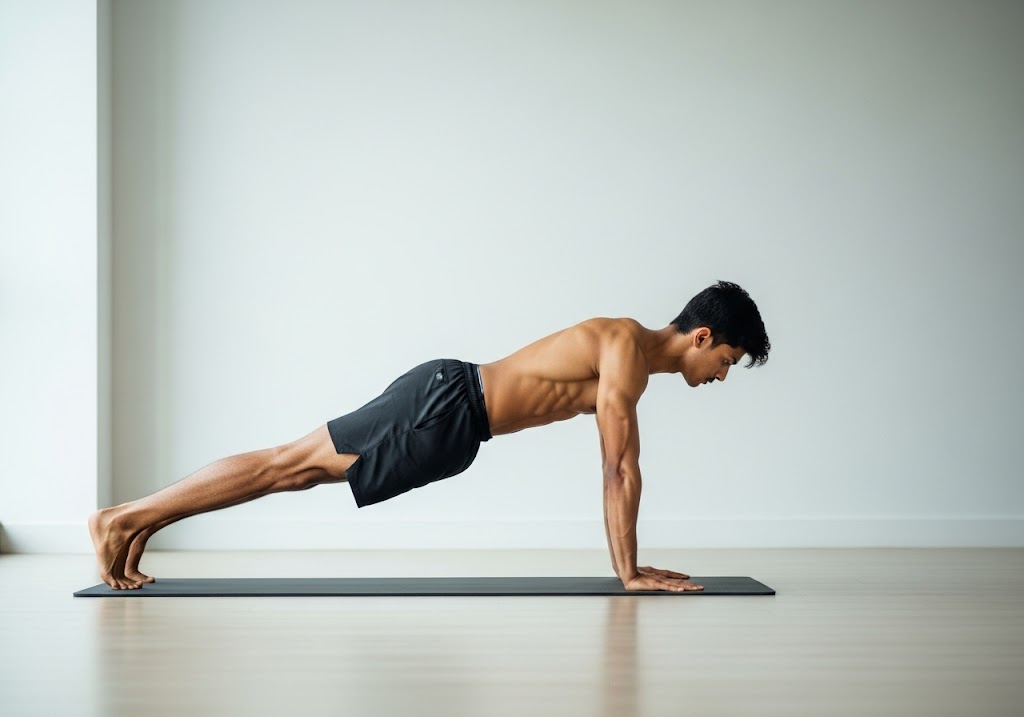
How to Do Plank Exercise for Beginners (Step by Step)?
Learning how to do plank exercise as a beginner requires patience and focus on proper form rather than duration. This detailed guide ensures you build a solid foundation while avoiding common mistakes that can lead to injury or reduced effectiveness.
Step 1: Setup Position
Begin learning how to do plank exercise by positioning yourself on your hands and knees. Lower yourself onto your forearms, ensuring your elbows are directly under your shoulders. This starting position helps you understand proper alignment before moving to the full plank.
Step 2: Leg Extension
Extend your legs behind you one at a time, balancing on your toes. Keep your feet hip-width apart for stability. This gradual approach to learning how to do plank exercise helps you maintain proper form throughout the transition.
Step 3: Body Alignment Check
Create a straight line from your head to your heels. Avoid common mistakes like raised hips or sagging lower back. Understanding how to do a proper plank exercise requires constant awareness of your body position.
Step 4: Core Activation
Engage your abdominal muscles by drawing your belly button toward your spine. This activation is crucial for learning how to do plank exercise effectively and safely supporting your lower back.
Step 5: Hold and Breathe
Maintain the position while breathing steadily. Start with 15-30 seconds and gradually increase duration as you master how to do plank exercise with proper form. Remember, quality always trumps quantity when learning how to do plank exercise.
For beginners, incorporating proper warm up exercises for beginners before attempting planks helps prepare your body for the exercise and reduces injury risk.
How to Do a Proper Plank Exercise? – Correct Form
Mastering how to do a proper plank exercise requires attention to specific form details that maximize effectiveness while minimizing injury risk. Proper technique ensures optimal muscle engagement and creates the foundation for advanced variations and progressive improvement in your fitness journey.
- Forearm Placement: Position your forearms parallel to each other with elbows directly under your shoulders. This alignment creates a stable base that supports your entire body weight effectively while learning how to do plank exercise correctly.
- Neutral Spine Alignment: Maintain a straight line from your head to your heels, keeping your head in line with your spine. Avoid looking up or dropping your head down to ensure optimal muscle engagement when learning how to do plank exercise.
- Core Engagement: Draw your belly button toward your spine and tighten your abdominal muscles as if preparing for impact. This active core engagement is crucial for understanding how to do a proper plank exercise safely and effectively.
- Shoulder Stability: Keep your shoulders directly over your elbows, avoiding any forward or backward positioning. This stable shoulder position prevents upper body strain and maintains proper form when learning how to do plank exercise.
- Hip Positioning: Keep your hips level with your shoulders and ankles, maintaining that essential straight line. Neither raised nor sagging hips compromise the effectiveness of learning how to do plank exercise properly.
- Leg Activation: Squeeze your quadriceps and glutes to maintain proper body tension throughout the hold. This full-body engagement maximizes the benefits of learning how to do plank exercise correctly.
- Breathing Control: Maintain steady, controlled breathing throughout the hold, avoiding the common mistake of holding your breath. Consistent breathing ensures proper oxygen flow when learning how to do plank exercise effectively.
Start with bodyweight exercises for beginners.
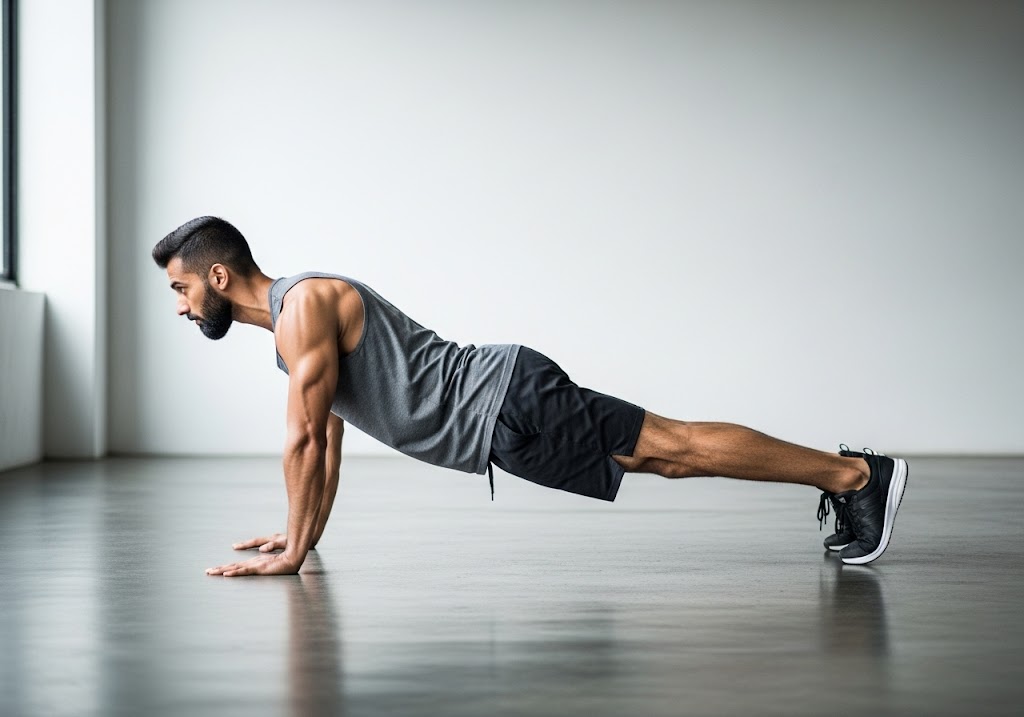
How to Do Plank Exercise at Home?
Learning how to do plank exercise at home provides convenient access to one of the most effective core exercises without requiring expensive equipment or gym memberships. You need only a flat surface with enough room to extend your body fully, making it perfect for home fitness routines. A yoga mat or carpet provides cushioning for your forearms and helps prevent slipping during the exercise.
The convenience of learning how to do plank exercise at home means you can practice daily without time constraints or travel requirements. This accessibility allows you to focus on proper form without distractions, making it easier to concentrate on technique details and muscle engagement. Consider incorporating planks into comprehensive calisthenics at home no equipment routines for balanced fitness development that maximizes your home workout effectiveness.
What Muscles Do Plank Exercise Work?
Understanding which muscles are activated helps you appreciate why learning how to do plank exercise is so effective for comprehensive core development. This full-body exercise engages multiple muscle groups simultaneously, creating balanced strength development.
| Muscle Group | Primary Muscles | Function | Training Benefit |
| Core | Rectus abdominis, transverse abdominis, internal/external obliques | Spine stabilization, posture support | Core strength, stability |
| Shoulders | Deltoids, rotator cuff muscles | Upper body support | Shoulder stability, endurance |
| Arms | Triceps, biceps, forearms | Body weight support | Arm strength, grip endurance |
| Back | Erector spinae, latissimus dorsi, rhomboids | Spinal alignment | Back strength, posture |
| Legs | Quadriceps, glutes, calves | Lower body stability | Leg endurance, stability |
| Hip Flexors | Iliopsoas, rectus femoris | Hip stability | Hip strength, flexibility |
Common Mistakes That Reduce Plank Exercise Benefits
Avoiding common errors helps you maximize the effectiveness of learning how to do plank exercise while preventing injury and ensuring optimal results. These mistakes can significantly reduce exercise benefits and lead to poor movement patterns.
- Sagging Hips: Allowing your hips to drop below the straight-line position reduces core engagement and places excessive stress on your lower back. Focus on maintaining that crucial straight line from head to heels when learning how to do plank exercise.
- Raised Hips: Lifting your hips too high makes the exercise easier but reduces core muscle activation. Keep your hips level with your shoulders and ankles for optimal effectiveness when learning how to do plank exercise.
- Holding Breath: Restricting breathing during plank holds reduces oxygen flow to muscles and limits exercise duration. Maintain steady, controlled breathing throughout the hold when learning how to do plank exercise.
- Incorrect Elbow Placement: Positioning elbows too far forward or backward compromises shoulder stability and reduces exercise effectiveness. Keep elbows directly under shoulders when learning how to do plank exercise.
- Lack of Full-Body Tension: Failing to engage all muscle groups reduces the exercise’s effectiveness and can lead to compensation patterns. Activate muscles from head to toe when learning how to do plank exercise.
- Excessive Duration: Holding planks too long with poor form is less effective than shorter holds with perfect technique. Focus on quality over quantity when learning how to do plank exercise.
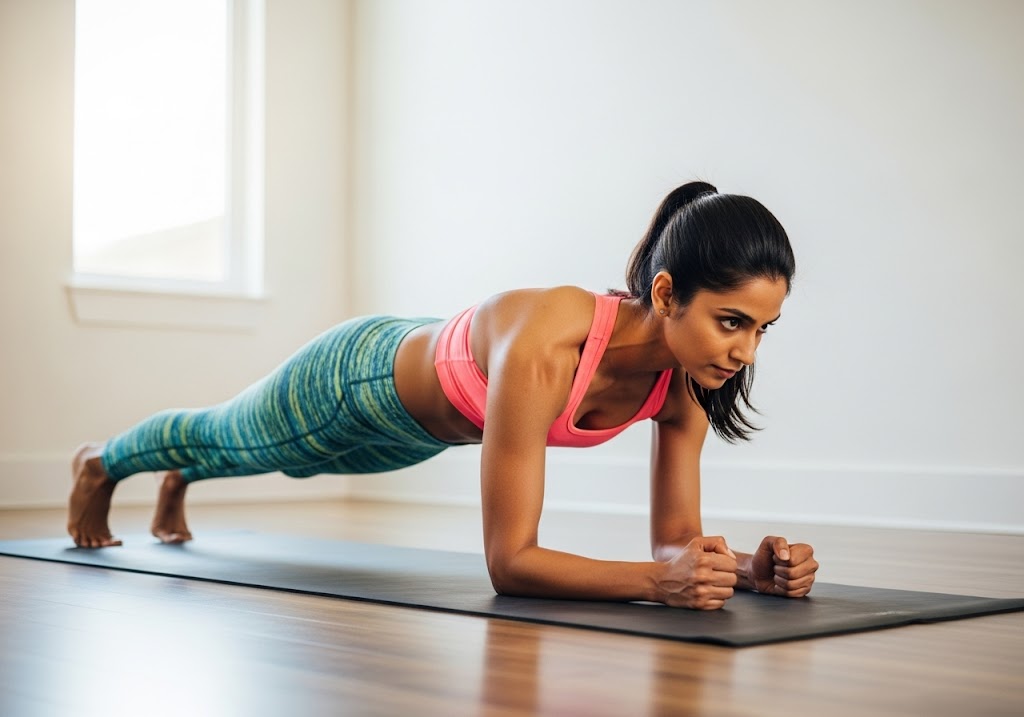
Advanced Plank Variations for Enhanced Benefits
As you master basic technique, exploring advanced variations helps you continue progressing and learning how to do plank exercise in more challenging ways. These modifications target specific muscle groups while maintaining the core benefits of traditional planks.
Advanced practitioners often integrate planks with other movements from calisthenics core workout routines. This combination approach creates comprehensive workouts that maximize fitness benefits while building upon your plank foundation. Understanding how to start calisthenics can help you progress from basic planks to more complex movement patterns. This progression ensures continuous challenge and development throughout your fitness journey.
Advanced Plank Variations:
Advanced plank variations help you continue challenging your muscles as you master how to do plank exercise. These progressions target specific muscle groups while maintaining the stability and strength benefits of traditional planks.
Plank Variations Overview
| Sr.No. | Exercise | Difficulty Level | Primary Target | Equipment Needed | Prerequisites |
|---|---|---|---|---|---|
| 1 | Side Planks | Intermediate | Obliques, lateral core | None | 30-sec standard plank |
| 2 | Plank Up-Downs | Intermediate | Dynamic core, shoulders | None | 45-sec standard plank |
| 3 | Single-Arm Planks | Advanced | Anti-rotation, unilateral core | None | 60-sec standard plank |
| 4 | Plank Jacks | Advanced | Cardio, core stability | None | 45-sec standard plank |
| 5 | Reverse Planks | Intermediate | Posterior chain, shoulders | None | 30-sec standard plank |
| 6 | Plank with Leg Lifts | Intermediate | Glutes, hip stability | None | 45-sec standard plank |
| 7 | Walking Planks | Advanced | Coordination, full-body | None | 60-sec standard plank |
| 8 | Plank to Pike | Advanced | Shoulders, hip flexibility | None | Strong standard plank |
Detailed Exercise Instructions
1. Side Planks
Side planks target oblique muscles and improve lateral core strength by challenging your body in the frontal plane of movement. This variation builds unilateral strength while addressing muscle imbalances often created by forward-focused activities and exercises. Side planks require significant shoulder stability and core control, making proper progression essential to prevent injury while building the lateral strength necessary for rotational sports and daily activities.
How to Do Side Planks?
- Lie on side with forearm on ground, elbow directly under shoulder, and stack feet on top of each other
- Lift hips off ground creating straight line from head to feet, avoiding rotation forward or backward
- Hold for 15-45 seconds per side, keeping body in single plane without allowing hips to sag
2. Plank Up-Downs
Plank up-downs combine static core stability with dynamic movement by transitioning between forearm and high plank positions repeatedly. This variation adds coordination challenges while maintaining core engagement throughout the movement transitions. The dynamic nature increases cardiovascular demand while building functional strength through movement patterns that require core control during position changes, mimicking real-world activities that demand stability during motion.
How to Do Plank Up-Downs?
- Start in forearm plank, press up to high plank one hand at a time, maintaining core engagement
- Lower back to forearm plank with control, alternating which arm leads each transition
- Perform 5-10 complete transitions, keeping hips level and minimizing rotation throughout movement
3. Single-Arm Planks
Single-arm planks remove one support point to challenge core stability and anti-rotation strength in ways that traditional planks cannot match. This unilateral variation demands exceptional core control while building strength imbalances often missed in bilateral exercises. The asymmetrical loading creates significant challenges for the deep core stabilizers while improving balance and proprioception through the destabilizing effects of removing one arm support.
How to Do Single-Arm Planks?
- Start in standard forearm plank, lift one arm off ground and extend forward or hold at side
- Maintain perfect plank alignment without rotating torso or shifting hips to compensate
- Hold for 5-20 seconds per arm, focusing on stability and control rather than maximum duration
4. Plank Jacks
Plank jacks add cardiovascular challenge to traditional plank holds by incorporating jumping leg movements while maintaining upper body stability. This dynamic variation combines core strengthening with cardio training, elevating heart rate while demanding exceptional core control during rapid leg movements. The combination makes plank jacks excellent for high-intensity circuits while building core endurance and cardiovascular fitness simultaneously through challenging coordination demands.
How to Do Plank Jacks?
- Start in high plank position, jump feet apart and back together while keeping hands planted firmly
- Maintain stable upper body and straight spine, avoiding bouncing hips or losing core engagement
- Perform 10-20 repetitions at controlled pace, prioritizing form quality over movement speed
5. Reverse Planks
Reverse planks target the often-neglected posterior chain while challenging shoulder stability and hip extension strength from an inverted position. This variation counteracts forward posturing from daily activities while building strength in the back muscles, glutes, and hamstrings. Reverse planks require significant shoulder flexibility and strength, making proper warm-up and gradual progression essential for safe execution and continued improvement without injury.
How to Do Reverse Planks?
- Sit with legs extended, place hands behind body with fingers pointing toward feet
- Lift hips to create straight line from head to heels, engaging glutes and posterior muscles
- Hold for 10-30 seconds, keeping chest open and avoiding sagging hips or excessive shoulder stress
6. Plank with Leg Lifts
Plank with leg lifts combine core stability with glute activation by adding unilateral leg movement to traditional plank holds. This variation challenges balance while specifically targeting hip stability and glute strength essential for athletic performance and injury prevention. The combination of isometric core work with dynamic leg movement creates comprehensive lower body and core training while building the coordination necessary for complex movement patterns.
How to Do Plank with Leg Lifts?
- Hold standard forearm plank, lift one leg 6-12 inches off ground while maintaining core stability
- Keep lifted leg straight and avoid rotating hips or compensating with upper body movement
- Hold for 2-5 seconds, lower with control, then alternate legs for 5-10 repetitions per side
7. Walking Planks
Walking planks add lateral movement to traditional plank holds, creating comprehensive core challenge while building coordination and full-body strength. This advanced variation requires exceptional core control while moving, mimicking real-world activities that demand stability during locomotion. Walking planks build functional strength while challenging multiple muscle groups simultaneously through the complex coordination required to maintain alignment during movement.
How to Do Walking Planks?
- Start in high plank, step right hand and right foot simultaneously to right side
- Follow with left hand and left foot to return to plank width, then reverse direction
- Take 3-5 steps in each direction, maintaining plank alignment and core engagement throughout
8. Plank to Pike
Plank to pike combines core strengthening with dynamic hip flexion and shoulder mobility through transitioning between plank and pike positions. This advanced variation builds functional strength while improving flexibility and coordination through multi-joint movement patterns. The transition challenges core control while requiring significant shoulder stability and hip flexibility, making it excellent for building comprehensive strength and mobility simultaneously.
How to Do Plank to Pike?
- Return to plank with control, maintaining core engagement throughout transition for 5-10 repetitions
- Start in high plank position, lift hips up and back into downward dog/pike position
- Keep hands planted and legs straight, creating inverted V-shape at top of movement
Consider incorporating these variations into routines that include calisthenics pull workout or back calisthenics exercises for balanced muscle development. Advanced practitioners might also explore forearm calisthenics to build supporting strength for longer plank holds.
Plank Exercise in Different Training Contexts
The versatility of learning how to do plank exercise allows for integration into various training methodologies and fitness approaches. Understanding these applications helps you customize your approach based on specific goals and preferences.
Many fitness enthusiasts wonder does calisthenics build muscle effectively. Planks contribute to muscle development while providing stability benefits, making them valuable additions to muscle-building programs that teach you how to do plank exercise for strength. The principles of calisthenics training apply perfectly to planks, making this exercise ideal for bodyweight exercises for beginners routines. This accessibility ensures consistent training regardless of circumstances while maximizing the benefits of learning how to do plank exercise. For those interested in comparing different training approaches, understanding crossfit vs calisthenics or calisthenics vs gymnastics can help you choose the best approach for your goals while learning how to do plank exercise.
Advanced practitioners might use planks as foundation exercises before progressing to more complex movements like calisthenics planche or specialized routines like calisthenics for triceps.
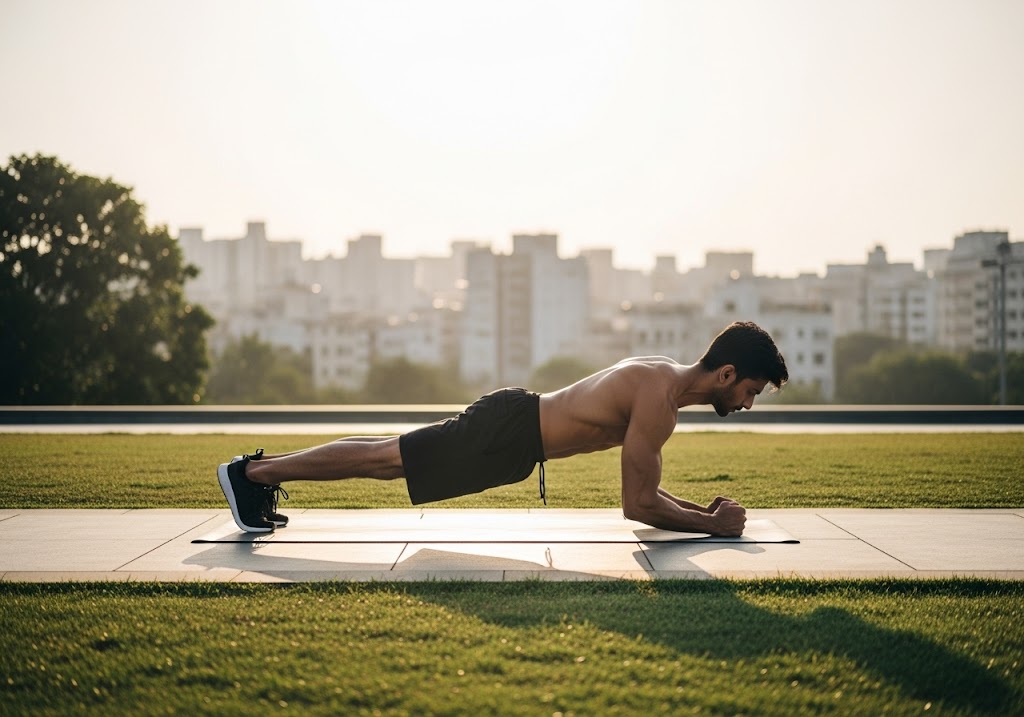
Scientific Evidence Supporting Plank Exercise Benefits
Research consistently demonstrates the effectiveness of learning how to do plank exercise for core strength, stability, and overall fitness improvement. Multiple studies have documented the core strengthening benefits of isometric exercises like planks, confirming that learning how to do plank exercise effectively leads to improved spine stability, better posture, and reduced risk of back injury.
Biomechanical research shows that learning how to do plank exercise correctly activates deep core muscles more effectively than many traditional abdominal exercises. The research on learning how to do plank exercise continues to evolve, with new studies regularly confirming the effectiveness of this fundamental exercise for building functional strength and preventing injury.
Conclusion
Learning how to do plank exercise correctly provides one of the most effective ways to build core strength and improve overall fitness. Start with proper form, progress gradually, and experience the remarkable benefits that make planks essential for lifelong health and functional strength development.
Want to master the calisthenics handstand and take your skills to the next level? Whether you’re a beginner or pushing advanced skills, ISC – Indian School of Calisthenics offers expert guidance to help you master bodyweight training. Visit us at SRPF Ground, NH8, Goregaon (E), Mumbai – 400065. For class schedules, personalized coaching, or more details, call +91 77159 53218. Train smart, move better, and unlock your back strength with ISC.
How to Do Plank Exercise? – FAQs
How long should I hold a plank as a beginner?
Beginners should start with 15-30 second holds, focusing on proper form rather than duration. Gradually increase time as strength improves.
What is the most common mistake when learning how to do plank exercise?
The most common mistake is allowing hips to sag or rise, breaking the straight-line body position essential for effective planks.
Can I do planks every day?
Yes, you can practice planks daily, but allow adequate recovery if you experience muscle fatigue or soreness from previous sessions.
How do I know if I’m doing a plank correctly?
A correct plank maintains a straight line from head to heels, with engaged core muscles and steady breathing throughout the hold.
Should I feel planks in my arms or core?
While your arms will work to support your body weight, the primary focus should be core engagement and stability.
How can I make planks easier if I’m struggling?
Modify planks by performing them on your knees, against a wall, or from an inclined surface to reduce difficulty while building strength.
When should I progress to advanced plank variations?
Progress to advanced variations when you can hold a standard plank for 60 seconds with perfect form and no fatigue.
Are planks effective for building visible abs?
Planks strengthen deep core muscles and can contribute to visible abs when combined with proper nutrition and reduced body fat.
What should I do if my wrists hurt during planks?
Perform forearm planks instead of high planks, or use push-up handles to maintain neutral wrist position during the exercise.
How do planks compare to other core exercises?
Planks are highly effective for building core stability and endurance, complementing dynamic exercises like crunches for comprehensive core development
